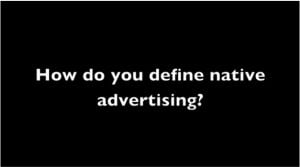
“Native advertising,” PR communicators have learned, is a form of paid advertising placement where the ad experience follows the natural editorial form and function of the environment in which it’s placed.
Put more simply, it’s advertising designed to resemble the editorial material the user consumes (although it’s never intended to mislead or fool the user).
While it is officially advertising, PR practitioners are often called on to develop and produce native advertising, because it’s in their wheelhouse. It’s what they’re better at than anyone else in the company.
But there are plenty of variables, and execution requires borrowing skills from both the PR and media buying disciplines. Ethan Bauley, senior vice president, digital communications, at Weber Shandwick, offers several suggestions for getting started—and executing correctly.
- There are two key principles for successful execution
- Start small with one or two simple native advertising products that clearly align to your marketing or business goal—promoted posts, tweets or video, for example.
- Get comfortable doing more math.
2. Partner with internal colleagues or an agency with hands-on experience.
- The definition of “native advertising” is debatable, but generally encompasses a broad range of social media ad products, publisher integrations, content syndication services, and beyond.
- Of these, there are a number of simple and/or mature platforms that are relatively simple to use and support common PR objectives.
- Individual pieces of content (like a blog post, “byline,” tweet, or other brand asset) often serve as the substance of a native advertisement.
- Given the definition of native, achieving clarity on brand voice and overall content strategy is foundational for success.
- Execution can be achieved with relatively modest investments and can deliver meaningful results (even at the scale of a small, local business).
- Look to partner with a colleague or agency that has executed these kinds of programs to help reduce risks and learn more quickly.
- For larger organizations, collaboration with marketing organizations is often a requirement and will be more effective if there is a sound business case supporting the investment of media dollars. These business cases can often be met with simple efficiency calculations like cost per click and CPM.
Follow Tony Silber: @tonysilber
